Population and Health Disparity Focus- Evaluation Plan for Evidence-Based Intervention 
Hello, and welcome to this Planning for evaluation presentation. This presentation will develop an evaluation plan for my evidence-based intervention for the Asia American community.
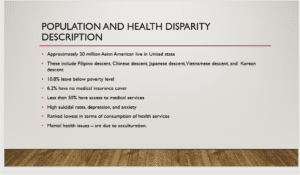
Approximately 20 million people are identified as Asian Americans in the United States, according to Mental Health America, Inc. (2021). These include Filipino descent, Chinese, Indian, Japanese descent, Vietnamese descent and Korean descent. 10.8% of Asian Americans live below the poverty line, and approximately 6.2% have no health insurance coverage. High rates of suicidal thoughts, depression, and anxiety disorder have been reported among many young adults, youths, and adolescents of Asian American origin. Low rates of access to mental health care services have also been reported among this population, with only less than 50% having access to these services. This, therefore, rates Asian Americans in the lowest rank when it comes to the consumption of mental health services. Factors contributing to high mental health issues among this population is acculturation, which affects their cultural beliefs, values, relationships, and behaviors. To address their mental health needs, culturally sensitive interventions need to be scaled up (Hwang and Ting, 2008).
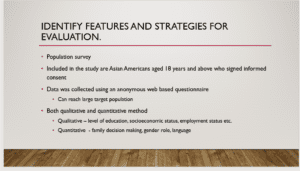
A population survey was considered the most appropriate method of evaluation of the population’s needs. Included in the study were all Asian Americans aged 18 years and above who signed informed consent to participate in the study, including communities, professional organizations, universities, and associations across the United States. The data were collected using an anonymous web-based questionnaire because it can reach many target populations without wasting a lot of time. Both qualitative and quantitative designs were used in the study. Included in the questionnaire was the number of people identified as Asian American, those with low levels of education, living below the poverty line, employment status, income levels, health insurance status for quantitative survey while mental health needs, family decision making, gender roles and language were recorded in the qualitative survey.
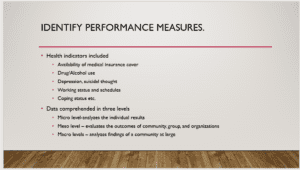
The health indicators used to measure the performance of Asian Americans were availability of medical insurance coverage, drug/alcohol use, eating habits, depression, suicidal thoughts, working status and schedule, coping status, adaptability to a new environment, sleeping pattern, cultural beliefs, mood changes and ability to concentrate at work or class. Three levels of mental health behavior will be used to comprehend the collected data. These include micro-level analysis in which the individual results are analyzed during the day-to-day conversations, confrontations, and negotiations. At this level, social stigma, mental health problems, and coping strategies are analyzed. The meso level evaluates the outcome levels of a group, community, or organization. It examines the social interaction between Asian Americans. Finally, the macro level is used to analyze the findings of a community at large (Bhui, 2020).
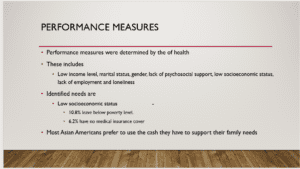
The health status of the Asian community was reported using the social determinant of health, which includes low-income level, marital status, low levels of education, low socioeconomic status, lack of psychosocial support, gender, lack of employment, and loneliness. Identified determinants of health affecting the mental health status of Asian Americans are high poverty levels and lack of insurance coverage. We established that approximately 10.8% of Asian Americans live in poverty, while 6.2% lack medical insurance coverage. Because of the cost of treating mental health problems and the associated stigma, the Asin Americans in Us living below the poverty line, choose to use the little cash they earn to meet their daily needs to care for their families rather than seeking for mental health.
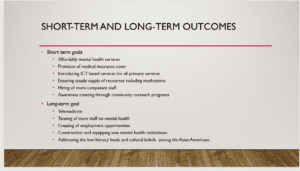
In order to address the mental health problems facing Asian Americans, the federal government ought to create a user-friendly environment that promotes the usage of mental health amenities. To achieve these, the following goals need to be addressed. Short-term goals; affordability of mental health services, provision of mental health insurance coverage to Asian Americans living in poverty who can not afford to pay for the coverage, introducing ICT-based services at all primary level services, ensuring a steady supply of mental health medications, technology and equipment used for treating mental health problems, increasing the workforce by employing more mental health specialists such as psychiatrists and nurses, creation of awareness on mental health at community levels. Long term goals; the federal and state government should put in place measures for training more mental health practitioners, creating employment opportunities, conducting f more research on mental health needs, measures to address the low literacy levels and cultural beliefs among the Asian Americans (Choi, et al., 2018).
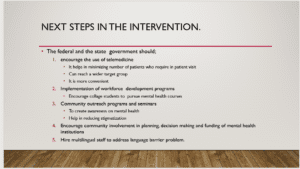
To overcome the barriers to addressing the mental health issues affecting Asian Americans, the federal and state governments should encourage the use of telemedicine as it plays an important role in minimizing the number of patients requiring inpatient care. Telemedicine also plays a critical role in ensuring that health care services reach a wider number of people in a convenient way that is suitable to all patients (Barnett, and Huskampm 2020). The government can also implement workforce development programs to allow for the provision of mental health training. College students should be encouraged to take a mental health course, including psychiatry and mental health nursing, to increase the number of mental health care providers. Community outreach programs and seminars should be conducted to create awareness of mental health to reduce stigma and encourage people to open up to seek help. Encouraging community involvement in planning, decision-making, and funding of mental health institutions to ensure smooth operations. Multilingual staff should be hired to help address language barrier problems (Ali and Watson, 2018).
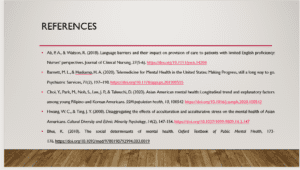
ORDER A PLAGIARISM-FREE PAPER HERE
We’ll write everything from scratch
Question 
Assessment Description
This assignment aims to develop an evaluation plan for your evidence-based intervention to reflect on its effectiveness.
Population and Health Disparity Focus- Evaluation Plan for Evidence-Based Intervention
You may choose to include key slides from your Population-Based Intervention Implementation Plan from Topic 5 in order to ensure that stakeholders have an understanding of the data collection and intervention planning processes.
Create a 5-8 slide PowerPoint presentation, not including title or reference slides, with the following information:
- Describe the population and health disparity targeted in the intervention.
- Identify features and strategies for evaluation.
- Identify performance measures.
- Write short-term and long-term outcomes with plans for measurement and benchmarking.
- Plan for the next steps in the intervention. What will you do with this evaluation data?
Include speaker notes for each slide, detailing how you would present this information to stakeholders.
Make sure to add citations on your slides (not just in the speaker notes).
Include one or two resources in your presentation.
While APA style is not required for the body of this assignment, solid academic writing is expected, and documentation of sources should be presented using APA formatting guidelines.